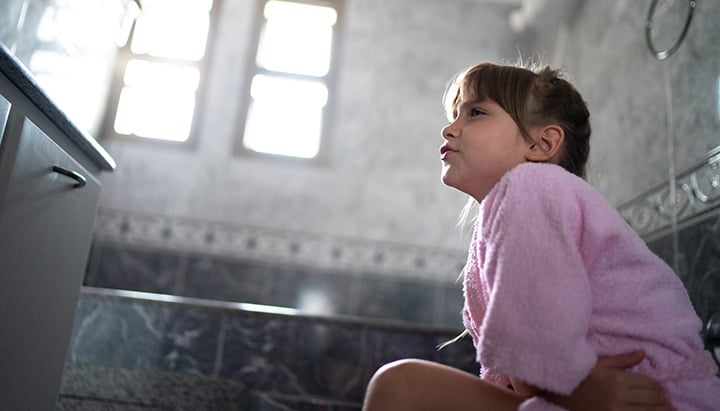What constipation in kids looks like and what you can do

Did you know constipation in kids can look like a lot of other things? You may be surprised to learn constipation in kids is often underdiagnosed and the right diagnosis can help your child finally get relief. Here are some signs to look for when you suspect constipation and how to get unstuck.
What is constipation?
Constipation is when you can’t poop, have difficulty pooping or feel like you have more stool even after trying to poop. Constipation doesn’t always mean full blockage, though it can. In fact, you can be constipated even if your poops aren’t hard or if you are pooping daily (if in small amounts). Constipation is related to how often the child poops, the amount of poop coming out and the consistency. Constipation can include some or all of these:
- Being unable to poop more than 2 times a week.
- Painful passing of hard stools.
- Passing small, rock poops.
- Feeling like you can’t get rid of all the poop at one time.
- Soiling when you have already bowel trained
Can anyone get constipated?
Yes, anyone can get constipated. Kids of any age can be constipated, though constipation is more common in toddler or preschool aged children who are learning to potty train and those with certain medical and neurodevelopmental conditions. Constipation is also common in school-aged children who may refuse to poop at school or hold in their poop.
Are there common medical causes of constipation?
Not really. Medical conditions (e.g., thyroid conditions, celiac disease, or Hirschsprung’s Disease) can cause constipation, but for most kids there is no identifiable medical cause for constipation. This is called functional or idiopathic constipation.
What can contribute to constipation:
- Change in diet, like from breastmilk to solid foods.
- Limited dietary fiber or fluid intake – although more important for those with very limited diet and fluid intake vs. those with a normal diet.
- During toilet training.
- After an illness or taking certain medications.
- Anxiety or stress from things like big life transitions or pressure at school.
- Poop avoidance, like not wanting to poop at school or outside the home.
- Medical conditions like Hirschsprung disease, irritable bowel syndrome or neurological disorder.
- Poor or slow motility of the gut.
- Lack of or insufficient toileting habits (e.g., sitting regularly, allowing time in the bathroom).
- Sometimes there are no identified contributors to constipation and that is OK – we still know how to treat it.
Warning signs of constipation
For kids older than 5, it can be pretty difficult to know their bathroom habits. You most likely have stopped tracking since they were able to go to the bathroom on their own. Even if you’re not helping them use the bathroom anymore, there are a few signs you can watch for:
- Going to the bathroom less than usual or more than usual (due to needing to stool but not being able to).
- Difficulty or straining to poop.
- Blood in the toilet or on toilet paper.
- History of passing large sized poop that can be difficult to flush.
- Soiling in their underwear.
- Frequent stomach pain or feeling bloated.
- Decreased appetite.
- Nausea or vomiting without being sick.
- Increased frequency of urinary incontinence.
What can parents do to help if their child is constipated
- Talk about poop regularly, so it becomes a comfortable topic to let you know if there is an issue.
- Be patient during potty training. This is often a time we see poop strikes because of the pressure to poop in the potty. Avoid a strike by being patient, not getting frustrated, offering privacy and rewards.
- Feed a varied diet with fiber from fruits, vegetables and grain and encourage enough water drinking.
- Use help if you need it. Over-the-counter laxatives like MiraLAX or senna can be helpful for relieving constipation in children. Consult with your child’s doctor about which medications might be right for them based on their symptoms, what medicines they can and will take and how long they have been constipated.
- Offer a bathroom routine so bowel movements can become regular. If there is trouble, try to have your child sit on the toilet to focus on pooping for at least 5 minutes about 20 to 30 minutes after meals. This may help them to relax and see if they have to go, taking advantage of their body’s natural functioning after meals.
Finding relief for constipation
Pooping should be an easy, non-painful and regular experience, but it sometimes isn’t for many children. If your child has issues with pooping, please talk with your pediatrician about options. Help is available and a long-term solution may take some time, so it’s best to get the process started early.
